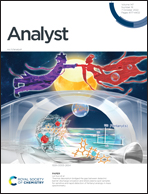Thermal desorption bridged the gap between dielectric barrier discharge ionization and dried plasma spot samples for sensitive and rapid detection of fentanyl analogs in mass spectrometry†
Abstract
The urgent threat of new psychoactive substances worldwide promotes rapid detection and identification demand for public security. Ambient ionization mass spectrometry (AIMS) has become mainstream among various detection techniques. Still, scant successful applications have been fulfilled toward dried blood spot (DBS) or plasma spot (DPS) as an easy-to-implement sampling format in AIMS. This work bridged the gap between dielectric barrier discharge ionization mass spectrometry (DBDI-MS) and DPS/DBS samples by thermal desorption (TD) assistance. It made the impossible mission of direct DBDI-MS measurement on DPS/DBS samples containing fentanyl analogs (FTNs) possible. Guided by finite element simulations and a customized three-dimensional printing interface, we constructed a semi-covered flat-TD surface for sufficient desorption and ionization of FTNs from DPS/DBS samples without any sample pretreatment or sample separation. We successfully quantified eight FTNs in DPS samples using deuterated fentanyl as internal standard by triple quadrupole tandem mass spectrometry (MS/MS) and proved its practical applicability in the fentanyl-exposed rat plasma samples. This DBDI-TD-MS method also fits well with DBS samples, and it only took 20 s to analyze each sample. Further, based on summarized fragmentation characteristics of twenty FTNs, we established a backbone alerting ion-guided screening rule for suspect screening of FTNs in DPS samples via quadrupole time-of-flight MS/MS and built a chemometric approach for convenient mutual verification of screening “unknown” artificial samples. We hope this ideal DBDI-TD-MS method finds its valuable role in national security, doping control, and public health for routine large-scale analysis or on-site detection.



 Please wait while we load your content...
Please wait while we load your content...